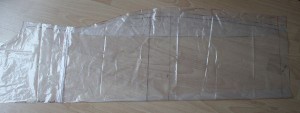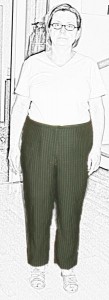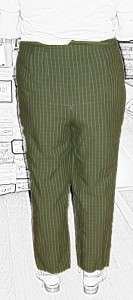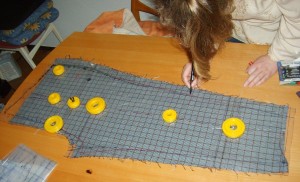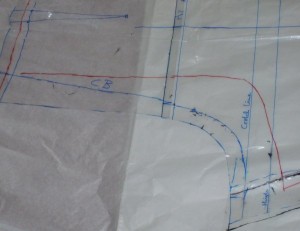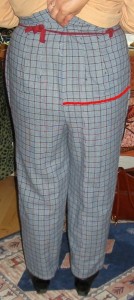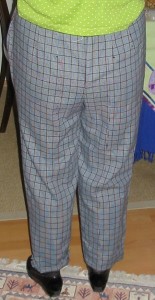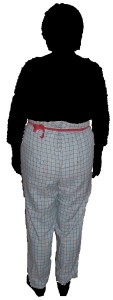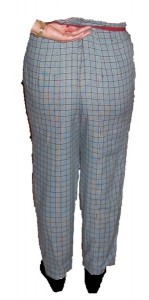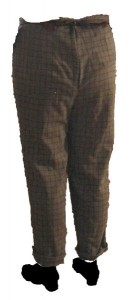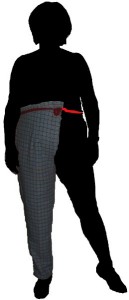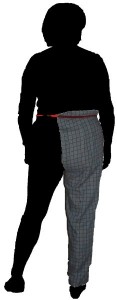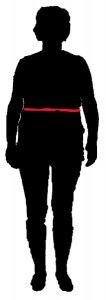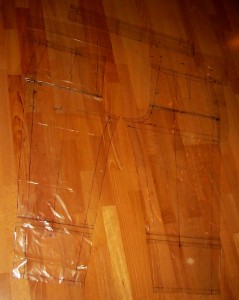Pants Fitting Shell Part 5
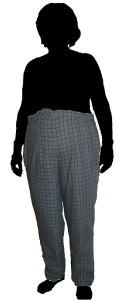
Frau mhs war fleißig und so konnten wir am Donnerstag die Hose mal als Ganzes anprobieren. Einen Verschluss hat sie vorne nicht, sie wird nur zugesteckt.
Das erste was uns bei der Anprobe auffiel war, daß das, was wir nach der letzten Anprobe an der Seitennaht zugegeben haben, als “Beutel” an der Seite abstand.
Außerdem ist es praktisch unmöglich, die Hose auf der Taille zu halten, wenn der Hosenbund knapp 4cm Zugabe hat. Das Konzept überzeugt mich nach wie vor nicht so recht…
Frau mhs finished the pants and we could check the fit. There is no front closure, you just pin it.
Last time we had, according to the instructions, let out a bit on the side seams. Well… this amount sticks out at the sides as little bags.
Also it is impossible to make the pants stay on the waist line, when the waistline ease is nearly 4 cm. This amount of ease does not really convince me…
Aber sonst sieht die Vorderseite gar nicht so schlecht aus für einen ersten Versuch. Die Hüftlinie ist gerade und parallel zum Boden und der Bauch paßt im Großen und Ganzen rein. An der Länge hatten wir ja viel zugegeben, das war aber tatsächlich nötig.
But apart from that, for a first fitting the front didn’t look to bad. There is basically room for the tummy and the marked hipline on the pants is straight and parallel to the floor. And the legs have the right length, which still surprises us, because we had lengthened them quite a bit and Frau mhs is normally petite.
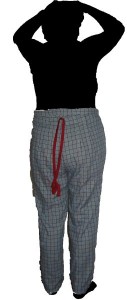 Die Rückseite hingegen…. das vertraute Bild mit den lustigen Falten und Schrägzügen. (Wie man die herausbekommt kommt in der Anleitung der fitting shell auch nicht vor.)
Die Rückseite hingegen…. das vertraute Bild mit den lustigen Falten und Schrägzügen. (Wie man die herausbekommt kommt in der Anleitung der fitting shell auch nicht vor.)
Außerdem fällt auf, daß die Pobacken sehr unterschiedlich sind. Links haben wir zu viel Stoff, rechts ist es eher knapp.
Aber wo der Schritt sitzt ist nicht festzustellen. Denn die Hose hält ja nicht in der Taille.
The back on the contrary… wrinkles and sagging as we know that. (And those wrinkles and folds ar not explained in the fitting shell.)
We also noticed, that Frau mhs back side is very asymmetrical. On the left there is to much fabric, the right side is a bit snug.
But we cannot find out where the crotch seam is positionned, because with 4 cm ease on the waist the pants do not stay up…
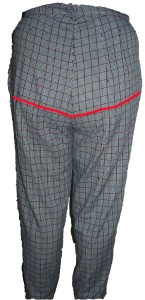 Also haben wir erst mal die Taille enger gesteckt, die beuteligen Zugaben von der “Halbanprobe” größtenteils wieder rausgenommen und dann die Rückseite noch mal genauer in Augenschein genommen.
Also haben wir erst mal die Taille enger gesteckt, die beuteligen Zugaben von der “Halbanprobe” größtenteils wieder rausgenommen und dann die Rückseite noch mal genauer in Augenschein genommen.
An der Seitennaht sitzt die Hüftmarkierung noch da wo sie sein soll. Aber zur hinteren Mitte hin fällt sie ab. Und die Schrittnaht kneift, wenn man versucht, die Hose so hoch zu ziehen, daß die Hüftlinie gerade ist.
So we first took the waistband in to make the pants stay on the waist and we took out most of what we had added last time after the “one leg fitting”. Then we took a closer look at the back.
At the fronts and on the side the hip line is on the hips and straight. But it goes down V-like to the back middle. And if I tried to pull the pants up, to make the hipline right, the crotch seam gets extremely… tight. Way to tight.
Intensives Studium der Anleitung erbringt…. das Problem kommt nicht vor.
Vogue sagt, wenn die Schrittnaht zu hoch sitzt, dann soll man rundum einen Stoffstreifen einfügen. Etwa 2cm wären wohl nötig. Dadurch würde aber die Schrittnaht vorne viel zu tief, denn da paßt sie so wie sie ist. Außerdem würde die Hüftmarkierung dann nicht mehr auf der Hüfte sitzen, sondern 2 cm darunter.
Also muß man wohl die Kurve der Schrittnaht ändern.
Das sieht die Anleitung aber nur für vorne vor. Hinten kommt das nicht vor. So weit zur Theorie. Das Problem für die Praxis lautet: Wie also die richtige Kurve finden?
We studied the instructions with care just to find out that this fitting problem is just not there.
The instructions tell you to insert a strip of fabric, about 2cm. But this would make the hip line come to low on the body. And the crotch would be to low on the front, there the crotch heigth is quite right now.
So it is quite evident, that we have to alter the shape of the crotch seam.
Only the instructions tell you only how to do that on the front. Changing the shape on the back is evidently a non existing problem. In theory. Reality is somewhat different…. So how to find the right shape for the back crotch seam?
Ich habe dann letztlich an der angezogenen Hose die Schrittnaht etwa von der Kreuznaht bis weit über die Hüfte hinauf aufgetrennt. Und dann die Nahtzugabe Am Po immer weiter nach innen gebogen, bis die Hose so weit nach oben gezogen werden kann, daß die Hüftmarkierung parallel zum Boden ist.
Ob das funktioniert wird man sehen. Bis zu unserem nächsten Treffen wird Frau mhs diese neue Nahtlinie an beiden Hinterhosen markieren, wieder eine Stütznaht nähen und die Hose so neu zusammen nähen. Außerdem wird sie an den Seitennähten zugeben, denn die Hose verliert dadurch über dem Po natürlich an Weite. Zudem haben wir schon gesehen, daß an den Oberschenkeln auch noch etwas Weite fehlt.
Vermutlich werden wir uns erst am Gründonnerstag wieder sehen, so lange heißt es jetzt also Geduld zu haben.
Und ich werde morgen meine zweite Runde über die h&h drehen. *Aua* sagen meine Füßte… *g*
Finally I took the seam ripper and opened up the back middle seam from between the legs and up, until about halfway between hipline and waistline. Then I folded in the seam allowance step by step, until the pants could be moved high enough, to make the hipline on the pants straight, parallel to the floor.
We don’t know whether this will be the solution. Frau mhs will use the fold as new seamline, will transfer it to the other side, make a staystitch and sew the seam. She will also let out the side seams, because the new back seam reduces the width over the bottom. Also we already could see that there also is not enough width for the thighs.
Our next meeting will be very probably Thursday before easter, so I’ll have to be patient until then to see whether this was the solution.
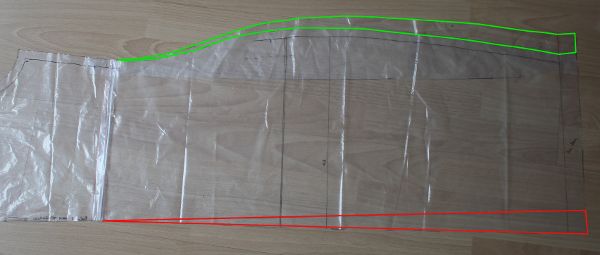
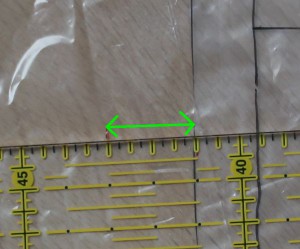 Um die neue Seitennaht zu bestimmen, gehe ich mit dem Patchworklineal Stück für Stück von der Taille nach unten. Ich messe den Abstand der zweite roten Linien (vom oberen Bild – also die hintere Mitte) und gebe genau auf der gleichen Höhe den Betrag an der Seitennaht zu.
Um die neue Seitennaht zu bestimmen, gehe ich mit dem Patchworklineal Stück für Stück von der Taille nach unten. Ich messe den Abstand der zweite roten Linien (vom oberen Bild – also die hintere Mitte) und gebe genau auf der gleichen Höhe den Betrag an der Seitennaht zu.